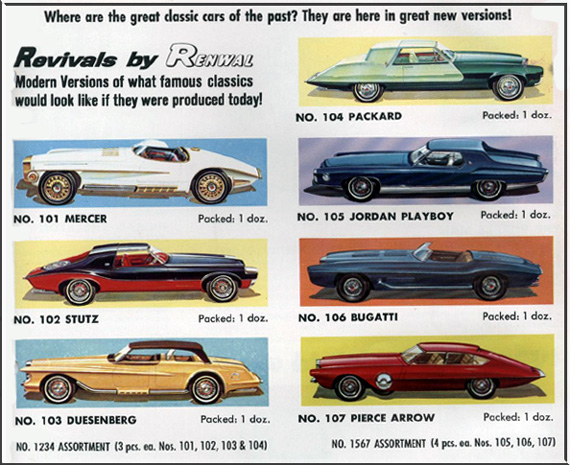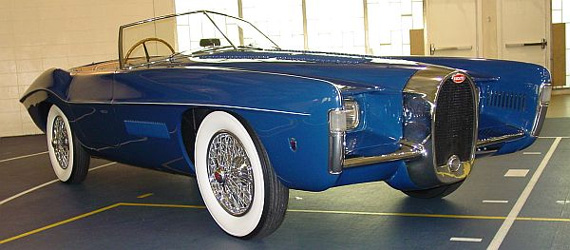 Catalog courtesy Peter Larsen.
Catalog courtesy Peter Larsen.
By Brandes Elitch
Photos courtesy of http://www.madle.org/
If you were a teenager in the 1960’s, as I was, you will remember that Renwal made a series of plastic 1/25 scale model car kits of the Revival Cars. Renwal Products was located in Mineola, NY. I have the ’66 Packard model. The box art says, “Modern Version of a Great Classic Car-Advance Showing.” There was even a slot car version, at least according to the assembly instructions. This is the story behind the Exner Revival cars.
In December of 1963 Esquire magazine published an article under the heading “Flights of Fancy.” It was titled “Introducing the 1964 Duesenberg, Packard, Stutz, and Mercer!” and written by Diana Bartley. It describes how the concept of the Exner Revival Classics, in particular the Mercer, Bugatti and Duesenberg designed by Exner with bodies constructed by Ghia and Sibona & Basano was brought to Exner.
Bartley sets the stage:
“Granted that American car design now ranges from acceptable to handsome, still, one of the ways our cars aren’t better than they used to be is that they all tend to look alike…anyone familiar with the individuality of so many of the great American cars of the past does notice – and cares.”
Bartley, who was a well-known automotive writer in the fifties and sixties, was one who cared. More than that, she had a notion and the opportunity to do something about it. She contacted Virgil Exner, recently retired VP of Styling at Chrysler. Exner and his son had a design consultancy business. Bartley broached the idea to them of creating sketches of a “modern parallel” to the great American cars which had what she called “immense marque identity,” but which no longer existed.
Choosing to work with the Exners was a stroke of genius for Bartley. As she relates, “…the Exners still believe that luxury-car buyers would welcome a return to the wide choice of luxury-car makes and models that was available almost until WWII.”
Exner Sr. commented, “We believe not only that greater stress should be put on the development and continuous refinement of a distinctive character for each marque, but also that the market for luxury cars can be greatly stimulated by some real effort to recapture some of the elegance and originality which make many of the old cars so interesting and exciting to us yet today.”
Bartley further comments, “You might think that the Exners are the theorizers…But they are more than that. They’re the doers.” Responding to her guidance, they actually produced four modern versions of the cars in the title for 1964. In creating the cars, Exner assumed that “… each manufacturer had pursued a policy of refinement and modernization of the cars’ identifying characteristics, and that each had decided to resume business after a thirty year lapse. What we are trying to do is to capture the spirit of the older car design and body type in a modern package.”
In the article, the Exners provided pencil sketches of the original cars and their modern version. There were four pencil sketches of each car, two of the front and two of the rear three-quarter views, along with their informative commentary. Above this was a 7-8 inch color rendering of the side view of each car.
Bugatti T101
